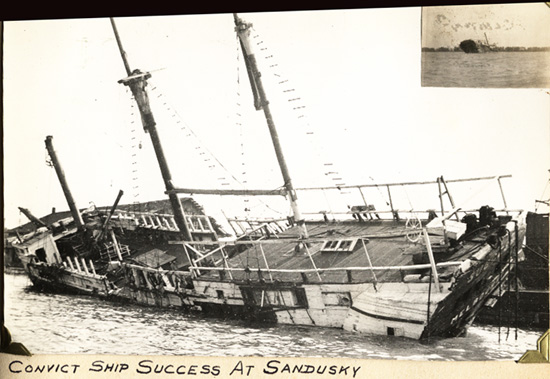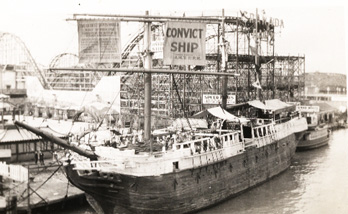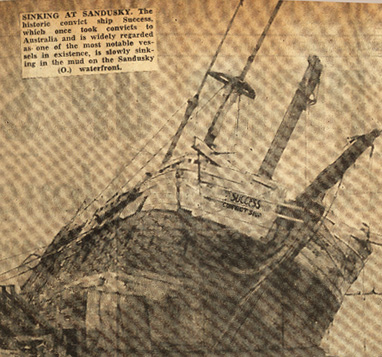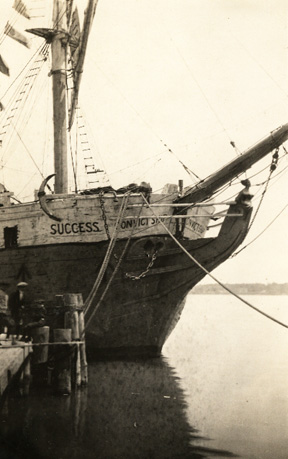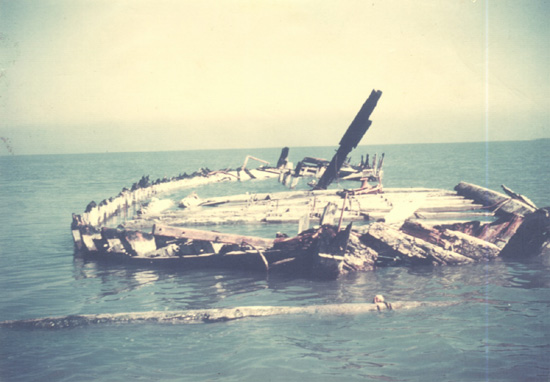Success
| Ship Name: | Success |
|---|---|
| Also Known As: | None |
| Type of Ship: | From Swayze's The Great Lakes Shipwreck File: "Barkentine, wood, 3-mast (all teak construction). Built in 1840, Natmoo Shipyard, Tenasserim, Burma as a full-rigged ship. (A flyer circulated with the ship when she was being displayed stated that she was built at Moulmein, Burma, in 1790. The information above is from Lloyd's, which does not list the ship before 1840.) |
| Ship Size: | 117' x 27' x 23' |
| Ship Owner: | Walter Kolbe of Port Clinton, OH |
| Gross Tonnage: | 622 |
| Net Tonnage: | NA |
| Typical Cargo: | Prison/Museum Ship |
| Year Built: | 1840 - Natmoo Shipyard, Tenasserim, Burma |
| Official Wreck Number: | None |
|---|---|
| Wreck Location: | 41 31.319 N 82 54.703 W |
| Type of Ship at Loss: | Barkentine, wood, 3-mast (all teak construction) |
| Cargo on Ship at Loss: | None (museum prison ship) |
| Captain of Ship at Loss: | None |
From David Swayze's The Great Lakes Shipwreck File: Total Losses of Great Lakes Ships 1679-2000: "July 4, 1946 - in Port Clinton, Ohio, fire. A Museum ship, she was built for the silk and emigrant trade. She was converted to a prison ship in 1857 and stationed at Sidney, Australia. She was abandoned and scuttled at that place in 1885, then resurrected in 1891 and toured the world as a 'convict ship' museum. She was re-rigged as a barkentine and came to the U.S. in 1912, leaving Liverpool, England, the same day as the Titanic and making the crossing in a long 98 days. She retired in 1939 at Port Clinton, Ohio. Burned by vandals on this date. No loss of life."
The following account is provided from Inland Seas, Quarterly Bulletin of the Great Lakes Historical Society, Volume 3, Number 2, pgs. 106-112, April, 1947:
Australia and the Success
A new light on the history of this much advertised and much written about ship has come from Herbert H. Hewitt, Chief of the Reference Department of the Chicago Public Library. Mr. Hewitt quotes a letter from Australia written in 1933, on file in the library, protesting the authenticity of the Success. The letter and the accompanying report are historically important and are printed herewith.
The Editor - For some time now an alleged Australian convict ship, the Success, has been on display to the public in American ports and has collected millions of dollars for her owners. Representations were made by our officials in New York with a view to putting a stop to this exploiting of the public and, at the same time, misrepresentation of early Australian history and conditions. To this end the Investigation Branch of the Commonwealth, with the assistance of this Library, made a complete investigation of the real facts and history of this old sailing ship. Thinking that these may be of interest to your library and through it may help to correct the impression which has been so widely disseminated, I have the pleasure in forwarding a copy of the results of the investigation.
Signed Kenneth Binne, Librarian
The Parliament of the Commonwealth
Library, Canberra, Australia
Dated 18th July, 1933
THE STORY OF THE SHIP SUCCESS
Early in 1885 the hulk Success - which had been put to many uses while at her moorings in Hobson's Bay, Victoria, for 32 years - was sold by the Victorian Government to Mr. Alexander Phillips. Mr. Phillips, aided by business associates, fitted her with prison cells, wax figures and implements of torture in what was regarded as the likeness of a convict transport. Following display and misadventure in Australian waters, the Success was taken to England in 1895, and after visiting many places in the United Kingdom and earning large profits for her Australian owners, she was sold in 1912 to a citizen of the United States and sailed across the Atlantic.
For twenty years this vessel has been shown at a charge of fifty cents at ports on seaboard, lake and river in the United States. The entertainment has been advertised in these words: - "THE BRITISH CONVICT SHIP SUCCESS" - "The World's greatest Educational Exhibit has been visited by over fifteen million people."
"Aboard her are now shown, in their original state, all the Airless Dungeons and condemned cells, the whipping posts, manacles, branding irons, punishment balls, cat o' nine tails, coffin bath, and other fiendish instruments of brutality. This wonderful vessel has made history through three centuries. She is the oldest ship in the world and the only convict ship left afloat out of that dreadful fleet of ocean Hells which sailed the Seven Seas in 1790. She marked the beginning and the end of England's Monstrous Penal System. She is unchanged after 135 years, nothing being omitted but the Human Freight."
These statements are untrue and they are gravely resented in Australia. The official representatives of Australia in the U.S.A. asked the Commonwealth Government in 1925 and in 1931 to explore the history of this vessel. A thorough investigation of official and other records has clearly established the fact that the ship now being exhibited in America was never used as a convict transport. She was utilized by the Victorian Government in 1853-1858 as an emergency prison while goals were in course of construction ashore. This fact is the foundation around which a legend has been invented for money-making purposes. When paying their fifty cents to inspect the Success, visitors are asked to buy, for ten cents more, a history of the ship ,which includes a catalogue of its alleged horrors.
The misinformation in this book was compiled by Mr. Joseph Harvie, an Australian, who traveled round the United Kingdom with the ship as publicity man, showman and lecturer. He may also have accompanied it in the U. S.A., as he died in Philadelphia in 1925. Harvie's first story was published in 1895, at the time the ship left Australia. It differs in some respects from the current American pamphlet, which has evidently been written up for trade purposes. Harvie's story and the result of official research in Australia agree that the ship Success, which left Australia in 1895 and is now in the U. S. A., is identical with a ship of the same name, of 621 tons registered which sailed from the Thames on 2nd January, 1852, carrying immigrants to Victoria, and arrived at Port Phillip on 24th May, 1852. Lloyd's Register, the acknowledged shipping authority, contains an entry relating to the vessel. Lloyd's Register for 1852 records seven vessels named Success. Five are small coasting craft, one is a small barque, and the last is a ship of 621 tons. The entry reads: "S 627 Ship of 621 tons, built of teak. Built at Moulmein in 1840. B. Steward, Master, trading between London and Port Philip." This is clearly the ship now under discussion. The Melbourne Argus, when recording the arrival of the vessel, gives her tonnage as 621. Australian official searches have not disclosed any visit of the Success to Australia before 1848. There are no records of any voyage made by her before that year, but there is evidence that for the first eight years of her life she was engaged in the trade between England and the East Indies. This information is confirmed by the Australian Cyclopedia (Angus & Robertson). (Harvie's first story states that she was in the China or Indian trade between 1830 and 1848). Harvie in his publication of 1895 says that the ship was built at Moulmein (so does Lloyd), but gives the year of building as 1790 (Lloyd says 1840 ). He quotes no authority. It is improbable that any British ship was built at Moulmein in 1790, as the ports and creeks of the Gulf of Martaban and Tenasserim were, until the first quarter of the 19th century, notorious as the haunts of Burmese and Malay pirates.
Their depredations on European ships led to the first Burmese War, and Moulmein did not become part of British territory until 1826. Next, Harvie states that the Success fought and defeated a pirate ship in the Bay of Bengal in 1815, adding that "great shot marks are still to be seen on the hull, close to the waterline." This statement is repeated in the American pamphlet, and suitable marks are now doubtless to be seen. If they are genuine, and the Success did encounter pirates, it must have been some time in the years 1840-1847. There were Chinese and Malay pirate craft in the Eastern seas then (and now) but they did not carry heavy guns. Harvie says that in 1829 the Success was chartered by the British Government to establish a colony at the Swan River (Perth W. A.).
There was a Success in Western Australian waters in 1827 and 1829, but she was a King's ship mounting 28 guns. H. M. S. Success is very well known to the historians of Western Australia. She was wrecked in Cockburn Sound, November, 1829, refloated, repaired, sent back to England, and finally broken up in 1833. In his first publication, Harvic mentions only one voyage upon which he says that the Success carried convicts, and that in or about 1849 "she took a promiscuous passenger list, bond and free from Botany Bay to Hobart Town." This is unlikely, as searches have failed to disclose any voyage by the Success to Tasmania during the period 1840 to 1850. It will be seen that the recorded voyages of the Success to Australia were made to the Colonies of South Australia and Victoria, neither of which ever received a convict from Britain. Transportation to New South Wales ceased in 1841, the year after the Success was launched when she was in Eastern waters. There was no transportation to Western Australia until 1857 and the Success was in Australian waters from 1852 to 1895. Transportation continued to Tasmania till 1852, but the ship's voyage in 1852 was to Port Philip, Victoria. The prior voyages of the vessel to Australia were to South Australia and Victoria to which countries convicts were never transported from Britain; nor was there any transportation to those countries from any place except in the case of Victoria which was, many years earlier, the scene of one experiment in convict settlement, which was very soon abandoned.
In the American pamphlet (probably copied from the book Harvie supplied to his British patrons) we are told that the Success was employed in the conveyance of convicts from 1802 to 1851, and in support of this assertion, the narrative states that Dr. White, Colonial Surgeon, made an official record of the maiden trip of the vessel as a convict ship in 1802. The pamphlet purports to give an extract from an official record of the maiden trip of the Success as a convict ship and quotes Dr. White, Colonial Surgeon, as having reported the number of prisoners who died during the voyages of the ships Success, Scarborough and Neptune. The report, however, appears in Mr. Charles White's book entitled "Convict Life in New South Wales and Van Diemen's Land" and the ships there referred to are the Surprise, Scarborough and Neptune. It is obvious that the Success has been substituted for the Surprise, in order to substantiate the alleged history of the vessel to which the pamphlet relates. A reference casually made to the Tolpuddle Martyrs, in a public speech twenty years ago by Mr. Arthur Henderson (subsequently Secretary of State for Foreign Affairs) has been mentioned as evidence of the authenticity of the narrative which the owners of the Success have sought to establish as true. The reference was invoked, in the following circumstances, in support of the allegations by the owners of the Success: In June 1931 the Success was exhibited in New York, apparently for the benefit of the Seamen's Church in that City.
Mr. D. M. Dow, Official Secretary for Australia in the U.S.A. saw the advertisements, and wrote to Mr. Haight, representative of the Seamen's Church, pointing out that the Success had never been a convict ship, and that she was built in 1840, not 1790. Mr. Haight replied, saying that he could quote the high authority of a British Cabinet Minister to prove that the Dorsetshire Martyrs suffered the rigours of the Success in 1834. Therefore she had been a convict ship, and she was afloat before 1840. He referred to a report in the South Dorset Liberal Monthly of June, 1912, of a speech at Tolpuddle by Mr. Arthur Henderson, M.P., when he unveiled a monument in memory of the Dorset Martyrs. Mr. Henderson is reported to have said that George Loveless and his associates were conveyed to Van Diemen's Land by the Success. The speech ascribed to Mr. Henderson in the South Dorset Liberal Monthly of June 1912 contains no reference to the Success. The report of his speech, however, is followed by an article headed "Tolpuddle Martyrs" in which the writer makes the statement that George Loveless was taken on board the ship Success on the 17th May, 1834. It is quite possible that this article was inspired by pamphlets published by Harvie before the article appeared.
The facts concerning George Loveless and his associates are as follows: - In 1834, George Loveless and some other Dorsetshire farm laborers formed a Trade Union. This was an offence for which the men were arrested, tried, convicted and shipped to the Antipodes. The severity of the sentence evoked indignant protests from British Liberals, and the convicts were released in 1838. It is clear from the foregoing that the convicts in question, having been released in 1838, could not have traveled on the Success, which was not built until 1840. That George Loveless and his associates were not transported on the Success is shown by the fact that in a pamphlet written by him and now in the Victorian Public Library he states that he was transported on the ship William Metcalfe (or Mitcalfe ) to Hobart Town. His associates travelled on the transport Surrey to Sydney.
SUMMARY OF HISTORY AND PROVED VOYAGES
The records of the history and proved voyages of the Success are as follows:
1840 - Built at Moulmein.
27/1/1848 - Arrived at Port Adelaide with immigrants. She met with a mishap at Port Adelaide and had to undergo repairs. (Harvie says that she made a voyage this year from Port Adelaide to Sydney. This is possible).
26/10/1848 - Left Port Adelaide for London. (Harvie says that in or about 1849 she carried bond and free passengers from Sydney to Hobart. This statement is examined above).
7/3/1851 - Arrived at Port Philip from London. (No convicts were ever brought from Great Britain to Port Philip) (See note at 7/3/1851).
1/7/1851 - Left Port Philip for London.
5/1/1852 - Left London for Port Philip.
24/5/1852 - Arrived at Port Philip with immigrants.
1/6/1852 - Berthed (or anchored) at Geelong, where she was deserted by her crew; who all went to the goldfields.
1852 - The Victorian Government bought her for use as a prison hulk. Although there was a great inflow of immigrants, they nearly all flocked to the goldfields, and there was very little labour available for building prisons or any other structures.
1857 - A working party of prisoners from the prison hulks killed Captain Price at Williamstown.
1858 - In or about this year the use of the hulk as a prison for men was discontinued.
1860 to 1869 - Used as a Women's prison and Boy's
1869 to 1884 - Used as a storeship for explosives.
1885 - Sold to Mr. Alexander Phillips who says, "I purchased her for to convert into a cargo lighter, but changed my mind and fitted her out for exhibition."
1885 to 1890 - In one of the rough notes on the Investigation Branch file it is mentioned that the ship was sunk in Sydney Harbour in 1885 and remained submerged for five years. W. Freame states (in the Morning Post) of 30/1/26 that she was submerged twice.
1890 - Exhibited in Melbourne.
1891 - Exhibited in Sydney.
1892 - On the 17th June she sank at her moorings in Kerosene Bay, Port Jackson. It has been asserted that she was deliberately scuttled, but according to another version she sank owing to leakage.
1893 - On the 27th February, "The Prison Hulk Success Co. Ltd." was formed in Melbourne to buy the ship from the owners, E. W. Nottingham, F. Long, J. E. Bendall, A. M. and F. C. Coles; to raise and exhibit her. It is said that only 20 pounds was paid for the wreck.
1894 - After having been re-fitted and furnished with wax figures, the ship was shown in Brisbane and Hobart. At Hobart she was given a certificate of seaworthiness by Lloyd's. Then she was sailed to Adelaide.
1895 - On the 30th March the Success left Adelaide for England, arriving in the Thames on 12th September. Mr. J. C. Harvie, had been appointed advance agent and lecturer for the British tour, and he was in charge of the ship for thirteen years.
1895 to 1912 - In British waters for 17 years, shown at every port where money was to be gathered. For several years it was a lucrative business for the Australian owners, but after the retirement of Harvie in 1908 "financial difficulties were encountered."
1912 - The ship was bought by an American (apparently Captain W. H. Smith) who refitted her at Glasson Dock near Lancaster, at a cost of 6,000 pounds, re-rigging her as a barquentine, and sailed her across the Atlantic. It is stated in the promoters' pamphlet circulated in America that the voyage was a hazardous one, and occupied 96 days.
1912 to 1932 - In North American Waters for 20 years. She was shown at all the principal ports, coastal, lake and river; on the Atlantic and Pacific sides, on the great Lakes, and on the Mississippi system. Captain Smith told the British Consul-General at Chicago in 1925 that it was a "tremendous paying game." A conservative estimate placed his receipts at 90,000 pounds a year, out of which he had to pay wharf rent, advertising, and the wages of a crew of 21.
1. Inland Seas Quarterly Bulletin of the Great Lakes Historical Society, Volume 3, No. 2, pgs. 106- 112, April, 1947.
2. Great Lakes Historical Society/Peachman Lake Erie Shipwreck Research Center Files
3. Swayze, David. 1999-2000. The Great Lakes Shipwreck File: Total Losses of Great Lakes Ships 1679-2000. http://www.oakland.edu/boatnerd/swayze/shipwreck
4. Kohl, C. 2001. The Great Lakes Diving Guide. Seawolf Communications, Inc., P.O. Box 66, West Chicago, IL, 60186.


